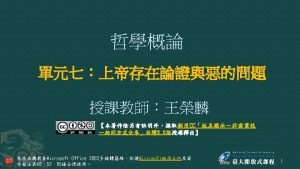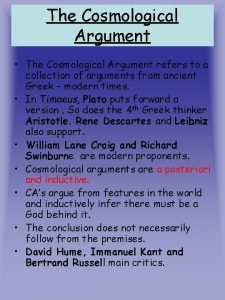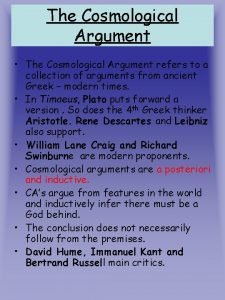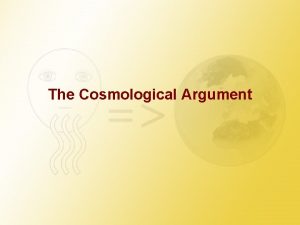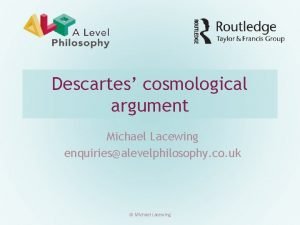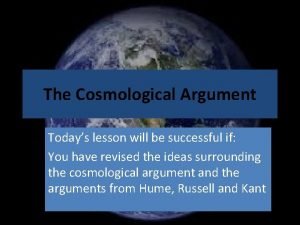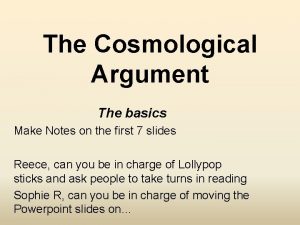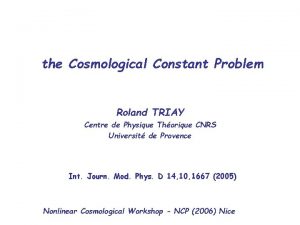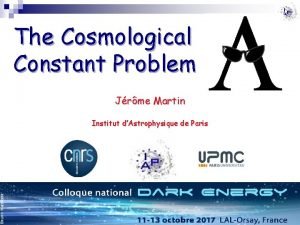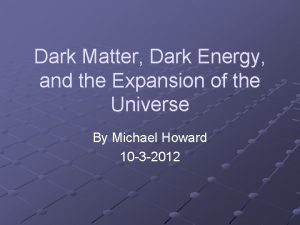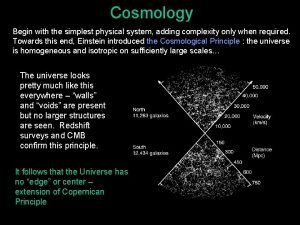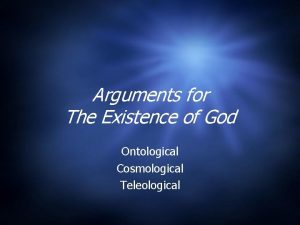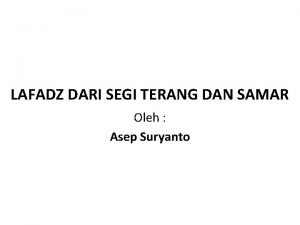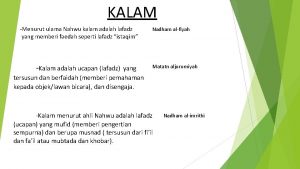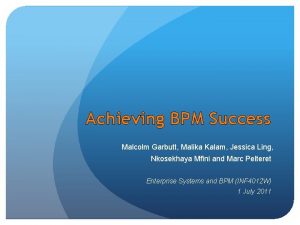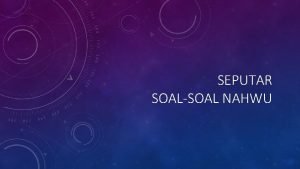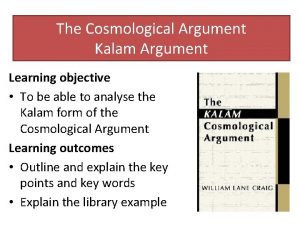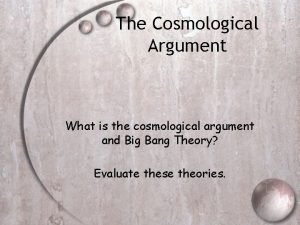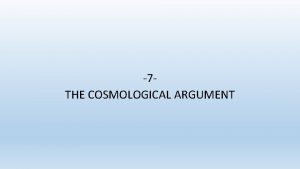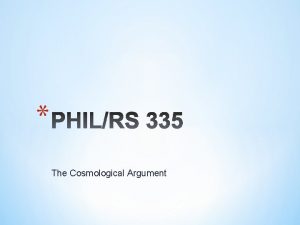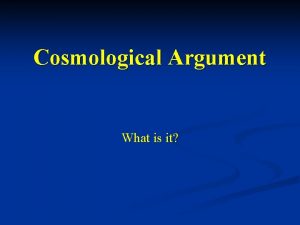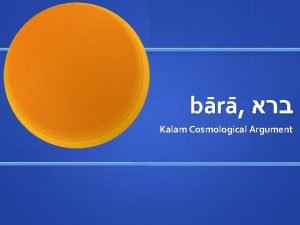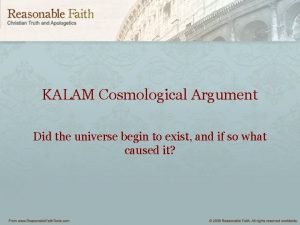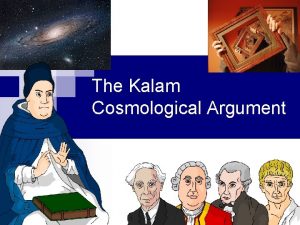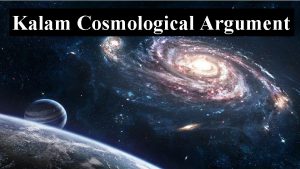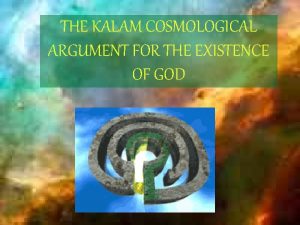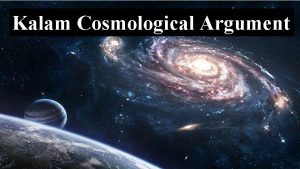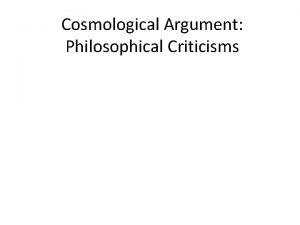1 A The Cosmological Argument Kalam Argument Learning

















- Slides: 17

1 A The Cosmological Argument Kalam Argument Learning objective • To be able to analyse the Kalam form of the Cosmological Argument Learning outcomes • Outline and explain the key points and key words • Explain the library example

Knowledge Check – on paper Complete the knowledge check activity 1. Is the Cosmological Argument inductive or deductive? 2. What does a posteriori mean? 3. Underline the correct definition to the key term. ‘The ability to become something else. ’ Potentiality or actuality 4. Did Aquinas use the example of fire and water or marble and sculptor? 5. Write a definition of infinite regress. 6. Is the second way referred to as ‘Motion and Change or First Cause’? 7. What example can we use for the second way? 8. What does contingent mean? 9. What does necessary mean? 10. What example did Copleston use to support Aquinas’ third way?

Starter – The Cosmological Argument so far. . . You have 30 seconds • Write down as many words connected to the Cosmological Argument you can remember • Swop your lists – count how many relevant words they found • Write brief definitions of the key words you know and then swop the lists again. Complete the Venn Diagram on page 2

Kalam – in booklet 2 – page 4 • An Arabic term meaning to ‘argue’ or ‘discuss’ • Argues that everything that exists has a cause of its existence and this includes the universe • William Lane Craig developed a modern version of the argument

History of the Kalam Argument page 4 • 850 CE – al Kindi and al Ghazali - Islamic thinkers who were influenced by Aristotle and developed the argument to explain God’s creation of the universe. • 20 th Century – William Lane Craig – American Christian The Kalam argument is cosmological because it seeks to prove that God was the first cause of the universe.

Summary of the Kalam Argument – page 4 Whatever comes into being must have a cause The universe came into being The universe must have a cause If the universe has a cause of its existence it must be God • God exists Supporters of this theory believe God created the universe ex nihilo ‘It is an axiom of reason that all that comes to be must have a cause that brings it about. The world has come to be. Ergo the world must have a cause to bring it about’ al Ghazali • •

Kalam- argues that God is the creator of the universe. üThe universe must be finite üA finite universe had a beginning üWhatever begins to exist has a cause üTherefore the cause must be God

William Lane Craig’s example used to support the Kalam Argument • Eg, imagine an infinite set of books in a library • A part of an infinite set is equal to the whole of the infinite set, because both the part and the whole are infinite. • A count of all the even numbered books is the same as a count of all the books • This does not make sense – so the universe can not be infinite

Activities • Read pages 4, 5 and 6 • Complete tasks 1 and 2 Whatever begins to exist, has a cause of its existence The universe began to exist Therefore the universe has a cause of its existence Explanation Argument 1 Actual infinite can’t exist Library Argument 2 Actual infinite can’t be formed Actual infinite Write down today's date can’t be formed Write down the year you were born You can count the number of years that have passed since you were born because you have a starting

Craig concluded that: • The history of the universe was formed by one event following on after another event – this is successive addition (birthday example) • A collection formed by successive addition cannot be actually infinite • Therefore, the universe must have had a beginning in time The argument aims to prove God as the personal creator of the universe. As the laws of nature cannot have existed before the beginning of the universe, the universe cannot be the result of natural causes, Craig claimed ‘if the universe began to exist, and if the universe is caused, then the cause of the universe must be a personal being who freely chooses to create the world. ’ Task 3 – Reread page 5 and 6 and complete page 7

Can you remember what these words mean? 1. 2. 3. 4. 5. 6. Valid A posteriori Sound Inductive A priori Deductive 1. From or after experience or evidence 2. The logic is correct and the premises are true 3. No mistakes in logic 4. If the premises are true the conclusion could still be false 5. If the premises are true the conclusion is true 6. Truth value determined before/without evidence

Kalam knowledge test 1. Kalam 2. Actual Infinity 3. Possible infinity 4. Ex Nihilo a. Derived from the Latin meaning ‘out of nothing’ b. An Arabic term which means to speak, argue or discuss c. It refers to sets or collections of things with an infinite number of members. A part within an actually infinite set is equal to the whole set because it is infinite. d. Exists if it always possible to add one more to a series of things or events.

Summary – pages 7 and 8 1. 2. • • • Inductive and a posteriori William Lane Craig’s premises Whatever comes into being must have a cause The universe came into being The universe must have a cause If the universe has a cause of its existence it must be God exists - Supporters of this theory believe God created the universe ex nihilo 3. Rejection of an actual infinite - The library example 4. Actual infinite can’t be formed - Successive additions 5. The personal creator, the universe cannot be the result of natural causes – frozen water

Consolidating WLC programme Make a note of any additional information http: //www. youtube. com/watch? v=6 Cul. Bu MCLg 0 Evaluating the argument

Just a Minute. Timer Number ones will ‘volunteer’ to start to speak about the Kalam Cosmological Argument. At the first repetition, pause or mistake another takes over - and so on until the minute is up.

Challenges to the cosmological argument Can you think of any challenges to the cosmological argument? Use page 9 of the Summer Preparation Work Booklet

Revision Activity one - Key word bingo A posteriori Valid Natural theology Aquinas Plato Aristotle Summa Theologica Inductive Deductive Cause Mover Theistic proof Christianity Sound A priori Activity two Either Choose five of the words on the list and put them together into a paragraph – that makes sense – and demonstrates your understanding of meaning Or Choose five of the words that you are unsure about and check your notes from the last lessons and create a key word list
 Argument from contingency
Argument from contingency St thomas aquinas cosmological argument
St thomas aquinas cosmological argument St thomas aquinas cosmological argument
St thomas aquinas cosmological argument St thomas aquinas cosmological argument
St thomas aquinas cosmological argument Descartes cosmological argument
Descartes cosmological argument Kant's criticism of cosmological argument
Kant's criticism of cosmological argument Contigency argument
Contigency argument Cosmological constant
Cosmological constant Cosmological constant
Cosmological constant Einstein cosmological constant
Einstein cosmological constant The universe expanding than
The universe expanding than Ontological cosmological teleological
Ontological cosmological teleological Dzahir dalalah
Dzahir dalalah Network marketing abdul kalam
Network marketing abdul kalam Arti dari kalam
Arti dari kalam Malika kalam
Malika kalam Lidwin lobo
Lidwin lobo Berikut ini manakah yang merupakan syarat-syarat kalam
Berikut ini manakah yang merupakan syarat-syarat kalam
